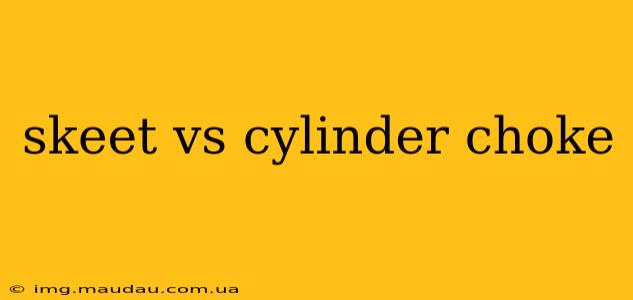Skeet vs. Cylinder Choke: Which is Right for You?
Choosing the right choke for your shotgun can significantly impact your shooting performance, particularly in different disciplines like skeet shooting. Understanding the differences between common choke types, such as skeet and cylinder chokes, is crucial for optimizing your accuracy and enjoyment. This article delves into the specifics of skeet and cylinder chokes, helping you determine which best suits your needs.
Understanding Shotgun Chokes
Before diving into the specifics of skeet and cylinder chokes, let's quickly review what shotgun chokes are and how they work. A choke is a constriction at the muzzle of a shotgun barrel that affects the pattern of the shot pellets. Different chokes create different patterns: tighter patterns for longer ranges, and wider patterns for closer targets.
Skeet Choke: Designed for Close-Range Targets
A skeet choke is designed for close-range targets, typically those found in skeet shooting. It provides a relatively open pattern, allowing for a wider spread of shot pellets. This is essential in skeet because the targets are presented at relatively short distances, and a tight pattern could easily miss. The wider pattern increases the chance of hitting the target, especially considering the fast-moving nature of clay pigeons in skeet. Key features of a skeet choke include:
- Wide shot pattern: Maximizes the chances of hitting the target at short ranges.
- Improved target acquisition: The wider spread makes it easier to lead the target effectively.
- Ideal for skeet shooting and other close-range disciplines: Perfect for bird hunting at close distances.
Cylinder Choke: The Most Open Choke
A cylinder choke is the most open choke available. It offers the widest shot pattern of all choke types, creating a large, dispersed spread of pellets. Because there is virtually no constriction, the shot pellets leave the barrel with minimal alteration to their trajectory. This results in a pattern that's best for very close-range shooting where a wide spread is needed to cover a larger area. Key characteristics of a cylinder choke include:
- Widest shot pattern: Excellent for extremely close-range targets.
- Minimal constriction: Allows for a very open spread of shot.
- Suitable for close-range hunting and informal shooting: Not ideal for long-range shooting.
Skeet vs. Cylinder: Choosing the Right Choke
The choice between a skeet choke and a cylinder choke depends heavily on your shooting discipline and the range of your targets.
-
Skeet shooting: A skeet choke is almost always the preferred choice. The wider pattern compensates for the speed and close proximity of the targets.
-
Close-range hunting: Both skeet and cylinder chokes could be suitable, depending on the specific hunting scenario. A cylinder choke might be preferable for extremely close-range shots, while a skeet choke offers a slightly more focused pattern.
-
Long-range shooting: Neither a skeet nor a cylinder choke is ideal for long-range targets. For longer distances, you'd want a much tighter choke, such as a modified or full choke.
Conclusion: Understanding Your Needs is Key
Ultimately, selecting the best choke depends entirely on your shooting style and the type of targets you're engaging. Understanding the differences between chokes like skeet and cylinder allows you to make informed decisions and optimize your performance. Remember to always practice safe firearm handling and consult with experienced shooters or professionals for personalized advice.
